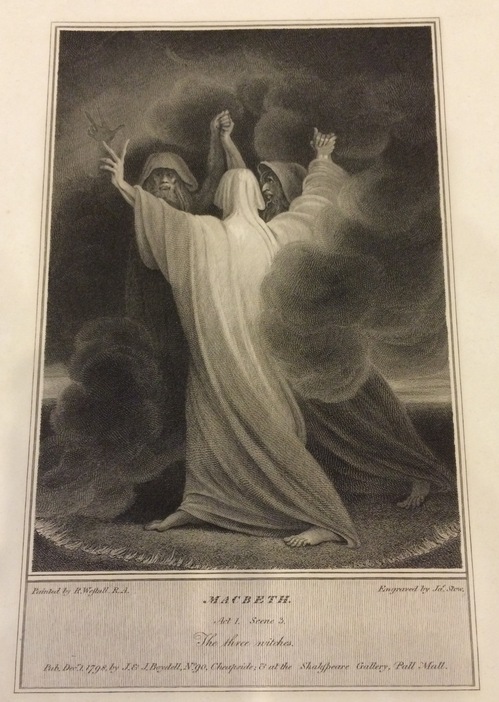his week, while browsing the Denison collection, my fellow researchers and I found some cross-dressing images. I’ll save those for later, but on a similar note, we also saw some images from Macbeth in the Honnold/Mudd library. Why is it similar, you ask? Because Shakespeare’s witches are not exclusively female.

(For your viewing pleasure–a drawing of a staging of Macbeth)
The witches in the Scottish play, interestingly, are never singled out as such by the characters, referred only to as the Weird Sisters. But, we may recognize them as such (if we were simply watching the play instead of reading the attributed lines) by their appearance given the social context surrounding witchcraft during the Renaissance. When the sisters first appear to Macbeth and Banquo, the latter cannot place their gender. He describes them as wild, withered, and with thin lips. Banquo even uses female pronouns, but pronounces that they “should be women,/ and yet your beards forbid me to interpret/ that you are so” (1.3.43-44). Essentially, the sisters are old bearded ladies.

(Image found in the Norman Philbrick Art Collection of the Honnold/Mudd Special Collections)
Some of you may be wondering why bearded old women equals witch. Well, there are a few factors at play, one of which being that the majority of persecuted witches in Early Modern England were old ladies living on their own. Supposedly, these witches cursed their neighbors with things like bad crops or domestic troubles. Typically, the English witches were widows, meaning that they had more monetary power than their younger and married counterparts. Back then, one of the only ways women could own property or have control over their money was if they were a widow. If their husband had owned property while alive, the wife would inherit the estate after his death if there were no other heirs. So, unmarried widows without a family had the potential for social deviancy–they didn’t need to rely on a man to support themselves.
What does this have to do with Macbeth? The weird sisters fit the above description of solo old woman with power of her own. Instead of having economic independence, Shakespeare’s witches have magical prowess and the power of prophecy. Also, we may see the Goddess Hecate’s appearance in the play as paralleling the connection between witches and the Devil.
But let’s get back to the beards. My interpretation is that the facial hair is a way to mark the gender deviance of the witches and to point to a masculine element in their character. The magic and independence points to a stereotypically masculine presentation and authority, resulting in the shifting of the witches’ gender expectations. It may follow that the internal shift may manifest externally, in this case, through the presence of beards. As a result, the weird sisters are both male and female, matching the transgressive image of the Early Modern English witch.